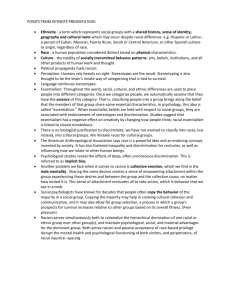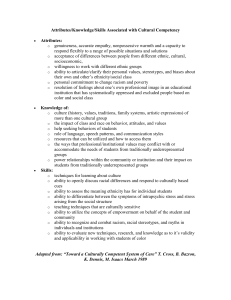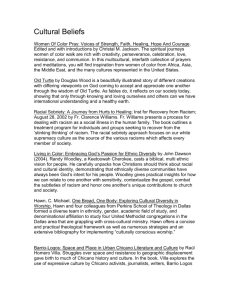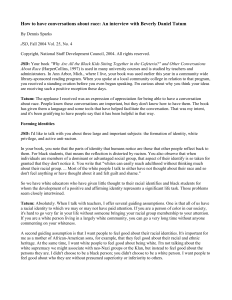Why are all the Black Kids Sitting Together overview as a
advertisement
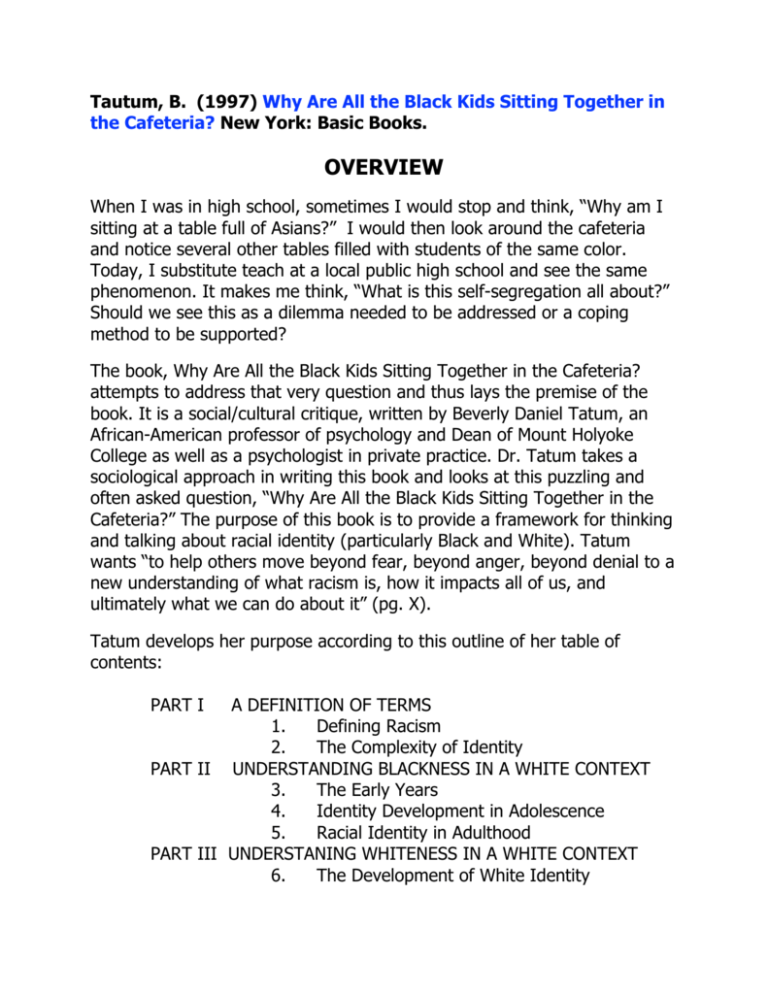
Tautum, B. (1997) Why Are All the Black Kids Sitting Together in the Cafeteria? New York: Basic Books. OVERVIEW When I was in high school, sometimes I would stop and think, “Why am I sitting at a table full of Asians?” I would then look around the cafeteria and notice several other tables filled with students of the same color. Today, I substitute teach at a local public high school and see the same phenomenon. It makes me think, “What is this self-segregation all about?” Should we see this as a dilemma needed to be addressed or a coping method to be supported? The book, Why Are All the Black Kids Sitting Together in the Cafeteria? attempts to address that very question and thus lays the premise of the book. It is a social/cultural critique, written by Beverly Daniel Tatum, an African-American professor of psychology and Dean of Mount Holyoke College as well as a psychologist in private practice. Dr. Tatum takes a sociological approach in writing this book and looks at this puzzling and often asked question, “Why Are All the Black Kids Sitting Together in the Cafeteria?” The purpose of this book is to provide a framework for thinking and talking about racial identity (particularly Black and White). Tatum wants “to help others move beyond fear, beyond anger, beyond denial to a new understanding of what racism is, how it impacts all of us, and ultimately what we can do about it” (pg. X). Tatum develops her purpose according to this outline of her table of contents: PART I A DEFINITION OF TERMS 1. Defining Racism 2. The Complexity of Identity PART II UNDERSTANDING BLACKNESS IN A WHITE CONTEXT 3. The Early Years 4. Identity Development in Adolescence 5. Racial Identity in Adulthood PART III UNDERSTANING WHITENESS IN A WHITE CONTEXT 6. The Development of White Identity 7. White Identity and Affirmative Action PART IV BEYOND BLACK AND WHITE 8. Critical Issues in Latino, American Indian, and Asian Pacific American Identity Development 9. Identity Development in Multiracial Families PART V BREAKING THE SILENCE 10. Embracing a Cross-Racial Dialogue Tatum defines racism as “a system of advantage based on race” (pg. 7). She argues that although not all White people are overtly prejudice, they collectively assert their racial advantage – access to better schools, housing, jobs, etc. Therefore, racism is a system that involves cultural messages and institutional policies and practices, not just beliefs and actions of individuals. By examining what Blackness means in a White context, Tatum explores reasons why a black person is socialized to think he or she is inferior or at least “not normal” in American society. She tells typical stories of how Blacks are misunderstood, misrepresented, and misused. She describes the different phases – childhood, adolescence, and adulthood - in which Black people develop self-identity and gives practical advice on how parents and other influences can shape a child’s thinking at an early age to value themselves. Then Tatum goes on to examine what Whiteness means in a White context. She explains that American society by default considers White people “the norm”. She argues that Whites need to embrace their Whiteness and develop a healthy, positive self-image without assuming superiority. Whites need to abandon their individual racism but recognize institutional and cultural racism. Tatum suggests that unless we are willing to examine issues of racial identity –whether we are White, Black or other – we will not be able to battle issues of racism. We need to embrace cross-racial dialogue and have it permeate all areas of society – home, school, houses of worship, workplaces, and community groups. Only then will the cycle of racism become increasingly visible, though uncomfortable. Only then will we be able to overcome it. Tatum concludes that there is nothing wrong with minorities wanting to be with their own racial group for a period of time to achieve a healthy selfesteem and empowerment. Minority, particularly Black, students need to go through a process of establishing and affirming their racial identity by securing a community free of negative stereotypes. Whites, on the other hand, need to give up their privilege that their skin color affords and to work actively to combat injustice in society. This book is a must for those who do not believe that racism still exists in America. It contains some of the most convincing arguments and illustrations of corporate racism I have ever read. Tatum convinced me that in order for racism to exist and permeate society, it needs to be a corporate, “a system of advantage based on race”. Therefore, because racism is administered systematically and corporately, it also needs to be addressed systematically and corporately. This book is a great introduction for those who are not aware of the systematic, corporate racism that persists in America. While Tatum does not come off as threatening to a White audience, she certainly is strong and challenging in calling White people into proactive participation in addressing racial issues. This book is also a must for anyone working in a multi-cultural setting. Not only does it deal with issues of racism, but it also deals with the issue of ethnic self-identity that is vital for both minority groups as well as majority groups. She challenged me to wrestle with the importance of racial identity more than any other book I have read before. Not only is racial identity needed to tackle racism, but also needed to build an individual’s, as well as a racial group’s, value and esteem. I was so moved and encouraged by the obvious passion and concern that came through Tatum’s insights and stories. I would ask all my friends, no matter what race they are to read this book. I believe it is a book that draws different races to value and appreciate each other more through deeper love and understanding. QUOTATIONS “It seems that “Why Are All the Black Kids Sitting Together in the Cafeteria?” – with that provocative question as its title – has served as an entry point, a conversation starter even for those who ordinarily avoid such conversations. And that indeed was an important goal.” (Introduction, Pg. IX). “People of color learn early in life that they are seen by others as members of a group. For Whites, thinking of oneself only as an individual is a legacy of White privilege” (pg. 102). QUESTIONS FOR REFECTION AND DISCUSSION • • • • Why is it difficult for people to talk about race issues? What is the cost for not talking about race issues? Who do you think it is hardest for to talk about race issues – White man, White woman, Black man, Black woman, Asian…Hispanic…etc? What is your argument? After reading this book, what do you think is the answer to the title question, “Why Are All the Black Kids Sitting Together in the Cafeteria?” IMPLICATIONS 1. Racial identity is or must become part of one’s maturing process throughout childhood and adolescence, and into adulthood. Without a healthy perspective of oneself that includes racial/ethnic identity one cannot develop a positive self-image. 2. Teachers, youth workers, parents, etc need to foster a safe and open environment concerning racial and ethnic discussion and exploration for our children. The earlier start they have in developing a healthy racial identity, the earlier they will develop a positive self-image and mature in other areas of life. 3. White people need to also get in on the discussion of race and racism even if they do not see themselves as racist or ethnic. They need to explore the subtle ways they participate in corporate racism. They also need to explore their own racial identity as White people – to be proud of their heritage but also repent of the history of White superiority and privilege. Anita Colombara, Copyright CYS

![[SOC 3AC] Niyogi F13 Midterm Exam](http://s3.studylib.net/store/data/008024599_1-cec01b60ef2f28fd40035e6e0b60c3ca-300x300.png)

